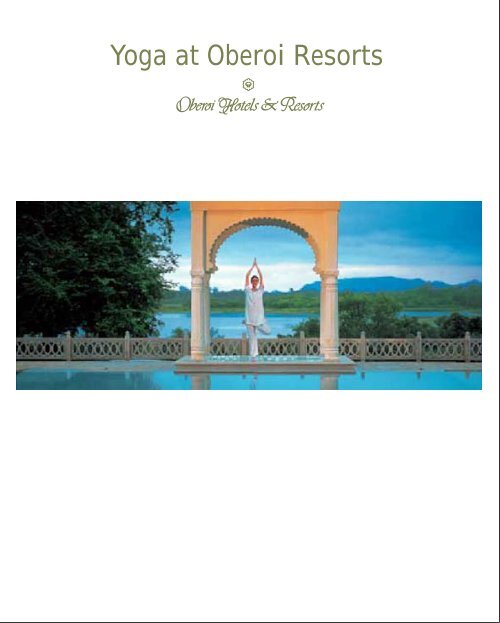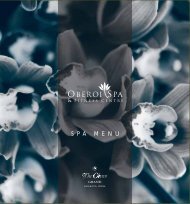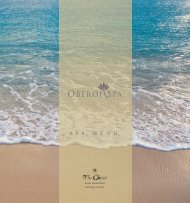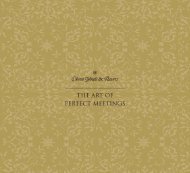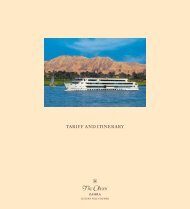summer tour brochure - Oberoi Hotels
summer tour brochure - Oberoi Hotels
summer tour brochure - Oberoi Hotels
You also want an ePaper? Increase the reach of your titles
YUMPU automatically turns print PDFs into web optimized ePapers that Google loves.
Yoga at <strong>Oberoi</strong> Resorts
GENERAL INTRODUCTION TO YOGA<br />
Philosophy is an attempt by the human mind to present the questions of life, existence and knowledge<br />
into a comprehensive and consistent framework. Of all the philosophical systems, the concept of body,<br />
mind and spirit evokes the most interest.<br />
Yoga balances the body, mind and spirit and ensures complete wellbeing.<br />
In India Yoga is not merely a philosophy, it is a way of life.<br />
In our modern, stress-filled world, daily practice of yoga is beneficial in itself, leading to improved health,<br />
emotional well-being and mental clarity. Yogic techniques can improve the general efficiency of<br />
individuals, as well as being of benefit in the prevention and cure of specific stress-related psychosomatic<br />
conditions. It has also been known to be useful in childbirth and for post-natal care. It can improve<br />
physical strength and flexibility and assist in the cure of sports related injuries and other illnesses.<br />
The most popular and widely practiced Yoga system is known as Hatha Yoga. This is based on the theory<br />
that the currents of vital force in our body flow through particular patterns. The way we think, feel and<br />
act depends on the nature of these patterns. The channels through which the currents of vital force flow<br />
are called "Nadis". There are innumerable such "Nadis" in a human being, all of which are interconnected<br />
and form plexuses in various regions. Any improper functioning of the body and/or mind is<br />
due to a disturbance in the passage of vital currents through one or more of these "Nadis". Hatha Yoga,<br />
therefore, deals initially with the problem of correcting this fault and opening the natural passage of the<br />
"Nadis" to enable the free flow of vital force currents. This process is called "Nadishuddi", which means<br />
"cleansing of the 'Nadis'". This can be done through various practices of Hatha Yoga, such as<br />
Shuddi Kriyas Asanas Pranayama Mudras<br />
Cleansing Practices Bodily Postures Creathing Techniques Yogic Seals<br />
The above benefits/effects of yogic practices seem to be possible through three types of mechanism:<br />
A. Direct influence on the body's organs, including muscles, joints, ligaments, visceral organs, etc.<br />
B. Influence on the autonomic nervous system<br />
C. Influence on the higher nervous system.<br />
While the first two mechanisms are involved in the maintenance and promotion of psychophysical health,<br />
the third governs the spiritual aspect of personality.
THE OBEROI UDAIVILAS SPA OFFERS<br />
THE FOLLOWING YOGA PRACTICES<br />
WITH OUR IN HOUSE YOGACHARYA<br />
I. YOGASANA AND BREATHING PRACTICES<br />
A) Traditional<br />
1) Gentle Yoga<br />
This gentle Yoga sequence is a complete series. The postures involved incorporate all the directions of<br />
motions a body can make, providing a normal range of joint motion, and developing tone and stamina in all the major<br />
muscles of the body. This series has a profound effect on the human body, and a subtle effect on the mind. It is most<br />
useful for the maintenance of health.<br />
2) Beginners' Yoga<br />
This beginners' level Yoga consists of elementary techniques designed to improve physical health and<br />
mental alertness, and heighten concentration. These effects are obtained through steady and comfortable stretching,<br />
and massaging and stimulating the energy channels and internal organs of the body. This session includes a set of<br />
specific postures, as well as relaxation and breathing techniques.<br />
3) Intermediate Yoga<br />
This session is for those who are adept at beginners' level Yoga and have been practicing for more than<br />
a year. The practices in this series develop strength, stamina and suppleness. A set of selected postures consisting of<br />
preparatory, main and counter poses, as well as relaxation and breathing techniques, are an integral part of this<br />
intermediate level class. Work includes preparation for an advanced group of bodily postures.<br />
4) Advanced Yoga<br />
This advanced level of Yoga is intended for people with considerable flexibility and strength, who have<br />
been practicing intermediate level Yoga regularly. The highlight of this session is the stimulation of the body' energy<br />
stations (also known as chakras) through a specific yogic sequence. This level also includes some advanced breathing<br />
practices that are both tranquilising and energising, and will prepare the aspirant for higher Yoga practices, such as<br />
Pratyahara (withdrawal of senses), Dharana (concentration), Dhyana (meditation) and Samadhi.
B) Dynamic Yoga<br />
Dynamic Yoga involves the combination of energetic movements of the body, yogic locks and breathing. It is a nonstop<br />
continuous practice for 90 minutes aimed at increasing flexibility, speeding up blood circulation, loosening the<br />
muscles and joints of the body, releasing energy blockages and removing stagnant blood from different parts of the<br />
body. The complete sequence tones the skin and muscles, strengthens the lungs, and encourages movement in the<br />
digestive and excretory systems. It has a profound effect at physical and causal levels.<br />
C) Yoga For Flexibility And Strength<br />
This is an individual centered Yoga programme nd includes three major factors to achieve a well-rounded programme<br />
that cultivates strength, tamina and suppleness. Every aspirant has different boundaries and limitations of movement<br />
in arious joints, which have a negative impact on health and prevent the development of flexibility and strength<br />
beyond a certain point. This session will help the aspirant more precisely practice a personalised Yoga programme.<br />
D) Yoga For Common Ailments<br />
Yoga is basically more preventive than curative. Recent scientific research shows that Yoga can tackle and manage<br />
many common ailments non-invasively. Yoga as therapy means the application of yogic practices for various medical<br />
disorders. Yogic management of various common ailments, such as respiratory, digestive, cardiovascular,<br />
gynecological, metabolic and orthopedic disorders, as well as pre- and post-natal Yoga, are taught in this session.<br />
[Note: For some specific disorders, a fitness certificate from a physician allowing the aspirant to undergo<br />
Yoga practices is required. The Yoga therapy taught is yogic methods of managing a particular condition<br />
and not a cure.]
E) Yoga For Your Constitution<br />
Ayurveda, the science of life, and Yoga are considered sister sciences and complimentary to each other. According to<br />
Ayurveda, an individual's body type can be classified into three categories, namely Vata (Air), Pitta (Fire) and Kapha<br />
(Phlegm). The different constitutions and changes in seasons play vital roles in the thinking, behaviour and action of<br />
an individual. This sequence of Yoga is aimed at bringing harmony to all three elements, which are popularly known<br />
as doshas.<br />
F) Monsoon Yoga<br />
According to Indian mythology, rain signifies the purification of the universe and the rainy season is considered an<br />
ideal time to detoxify the body. This Yoga programme combines Ayurvedic treatments available at The <strong>Oberoi</strong> SPA and<br />
Yoga practices designed for particular types of constitution which can speed up the purification of mind, body and<br />
spirit in order to achieve optimum health. This three-day session starts with relaxation, continues on to purification<br />
and ends with rejuvenation through Ayurveda and Yoga.<br />
G) Five-Elements Yoga<br />
The ancient yogis tell us that the whole universe is made up of five elements; ether, air, fire, water and earth. As the<br />
human body and mind is also made up of these same cosmic elements, their properties are present in the body. Their<br />
influence is so subtle and precise that they can affect the whole pattern of our life. After completing a set of Yoga<br />
practices, various techniques are used to recognise the predominant element at a given point in time. These elements<br />
are indicative of different psycho-physiological states. If the aspirant becomes aware of the active element, he/she<br />
can then judge his/her physical, mental and emotional state, and use different resources at his/her disposal for<br />
different tasks.<br />
H) Breathing Techniques<br />
Breath is life and life is breath. The process of life itself depends on how we breathe. Breathing is not only an<br />
instinctive reflex to satisfy the need of the cells for oxygen, but also it has been considered that consciously controlled<br />
breathing can be used as a technique to enhance mental and physical fitness. Yogic breathing practices have been<br />
applied to heal wounds and even to cure diseases. Different techniques of yogic breathing are taught in this session,<br />
including yogic methods to measure lung capacity, yogic seals, as well as balancing, tranquilising and energising<br />
techniques.
SPECIAL PACKAGE<br />
THREE-DAY REJUVENATING AND HOLISTIC AYURVEDA & YOGA PROGRAMME<br />
Ayurveda Yoga<br />
Ayurveda, the science of life, is a traditional and powerful natural healing system for body, mind and spirit. It is a<br />
tremendous resource for bringing completeness to all levels of human existence. Yoga is an excellent spiritual science<br />
that teaches the way to develop a human's full potential. Based on the assessment of an individual, this unique threeday<br />
programme offers personalised Yoga and Ayurvedic treatments.<br />
Day 1 (Relaxation) The first day is completely dedicated to the relaxation of body and mind. The<br />
morning Yoga session includes gentle postures to open up the body and is<br />
followed by deep relaxation to help the aspirant physically and mentally unwind.<br />
This is followed in the afternoon by a balanced Ayurvedic dry herbal massage.<br />
Day 2 (Purification) On the second day, the purification of the outer as well as the inner being is the<br />
main theme.The morning session includes yogic cleansing practices to purify the<br />
nasal cavity and gastrointestinal tract. The afternoon Ayurvedic treatment starts<br />
with a massage, followed by a neem purification bath.<br />
Day 3 (Rejuvenation) The third day starts with rejuvenation program in a set of specific yoga program<br />
session includes for the body type followed by Ayurvedic treatment of Shirodhara<br />
Shirodhara to rejuvenate the body and mind. The evening session of meditation<br />
allows detoxification of body, mind and spirit.
Dynamic Yoga involves the combination of energetic movements of the body, yogic locks and breathing. It is a non-<br />
Meditation is an inward movement within the consciousness by the consciousness itself. It is a steady, continuous flow<br />
of attention directed towards the same object. Meditation is a powerful way of controlling physiological processes and<br />
reactions to psychological events. Meditation reprogrammes the mind, leading ultimately to optimum health of body,<br />
mind and spirit.<br />
Prior to meditation, the complete understanding of concentration, meditation, meditational processes, the prerequisites<br />
for meditation, ideal postures, the breathing practices that contribute to meditation and misconceptions<br />
about meditation are explained. Effective ways of bringing harmony to the body, mind and emotions are also<br />
discussed.<br />
DIFFERENT TECHNIQUES<br />
There are a number of mediation techniques in Yoga, Tantras and Vedanta. However, the essence of all these varieties<br />
is in the different application of the witnessing process.<br />
Some of the techniques taught are:<br />
II. Meditation<br />
a) Meditation on Chakras<br />
Chakras are basic energy stations in the human body. Once the chakras are activated, they facilitate the movement of<br />
vital force without blockage in any part of the human body. In this type of meditation, the techniques used to<br />
stimulate and activate the chakras are taught.<br />
b) Nadanusandhan (Meditation on Sounds)<br />
This is the highest stage in the practice of Hatha Yoga. This technique is the method of penetrating the deeper layers<br />
of mind using sound as a medium. The manifest universe is considered to have sound as its basis. Science also says<br />
that everything in the universe is nothing but vibrational energy, and sound is a form of vibration. Yoga looks at the<br />
body and the mind as nothing but an uncountable number of different vibrations in a multitude of permutations and<br />
combinations. This practice tries to take the aspirant progressively through a series of steps to experience the<br />
ultimate goal, merging with the inner sound.<br />
c) Meditation on Breathing<br />
Based on the Sri Vigyana Bhairava Tantra, this technique is very simple yet powerful. Witnessing the breath<br />
transcending time, place and object are taught in this technique.
d) Shoonya Meditation (Meditation on Thoughtlessness<br />
This is a powerful way of becoming a witness to oneself and the world by activating the third eye (Ajna Chakra). This<br />
technique teaches how to detach from everything and become a principle witness.<br />
e) Trataka (Gazing) with Mantra Affirmations<br />
Through the practice of trataka (gazing), the subconscious mind is accessed. The negative thoughts stored in the<br />
mind are brought to a conscious level and replaced with positive mantra affirmations. This is a combination of Hatha<br />
Yoga and Vedanta Meditation.<br />
f) Any other meditation technique<br />
Any other meditation technique found in tantric literature, including Sri Vigyana Bhairava Tantra, Vedanta and Yoga,<br />
according to specific requests.<br />
C. YOGA NIDRA (PSYCHOSOMATIC DEEP RELAXATION)<br />
Yoga Nidra means sleep with a trace of awareness. It is a state of mind between wakefulness and dream. It is also a<br />
state of inner awareness and contact with the subconscious and higher consciousness. A state of highest relaxation is<br />
reached by turning inwards, as the consciousness is separated from external awareness and sleep. This practice<br />
effectively helps to reduce muscular, mental and emotional tension. It is a practice designed to totally and<br />
systematically relax, and more efficiently and effectively rest and rejuvenate the body, mind and soul. It is also a way<br />
to access the subconscious mind and thus restore creative genius.<br />
D. CLEANSING PRACTICES<br />
1. Jala Neti (cleansing through water) and Sutra Neti (cleansing through thread) - Neti is a process of<br />
cleansing the upper part of the respiratory system. It helps to clean and open the nasal passage and increase the<br />
sensitivity of the nasal mucosa. Jala Neti is the practice of cleansing the nostrils through salt water with a neti pot.<br />
Sutra Neti is nasal cleansing using a rubber thread.<br />
2. Danda Dhauti (cleansing through tube) - This is a cleansing process related to the digestive and respiratory<br />
system. About three litres of lukewarm salt water is taken through the mouth. A rubber tube about 90 cm long and<br />
0.5 cm wide is inserted into the mouth and taken to the stomach. All the stomach's contents are then expelled<br />
through the tube.<br />
3. Vastra Dhauti (cleansing through cloth) - This is a cleansing practice related to the gastrointestinal tract.<br />
Training is given on how to swallow a wet piece of cloth three inches wide and fifteen cubits long, which is then slowly<br />
drawn out.<br />
4. Laghu Shankapraksalana (washing of the intestine) - This cleansing practice is done with about 16 glasses of<br />
water, combined with six different postures, to stimulate peristalsis movement and wash the intestines thoroughly.<br />
This practice helps to cleanse almost the entire digestive tract.<br />
5. Vahnisara Dhauti (cleansing with essence of fire) - In this practice the movement of the abdominal muscle is<br />
used to create heat inside the organs, which are ultimately cleansed.<br />
6. Vamana Dhauti (regurgitate cleansing): - About five litres of salt water are used in this practice to cleanse the<br />
abdomen and esophagus.
E. LECTURES ON YOGA-RELATED TOPICS<br />
Lectures can be given on a variety of yogic scriptures including Patanjali Yoga Sutras, Hatha Pradipika, Gheranda<br />
Samhita, Ashtanga Yoga and Vasista Samhita.<br />
Other yoga-related topics will include the physiological significance of Yoga practices, yogic anatomy and physiology<br />
and Indian philosophies, amongst others.<br />
There are a number of mediation techniques in Yoga, Tantras and Vedanta. However, the essence of all these varieties<br />
is in the different application of the witnessing process.


